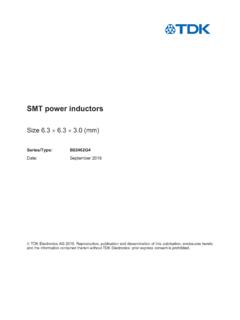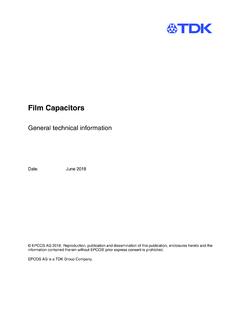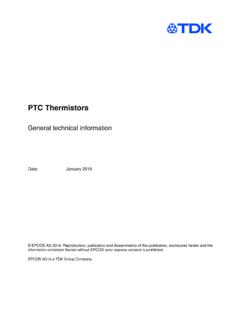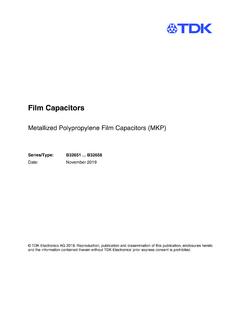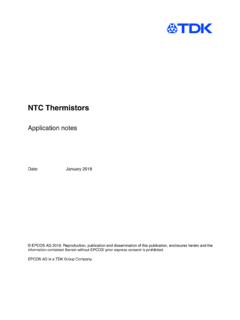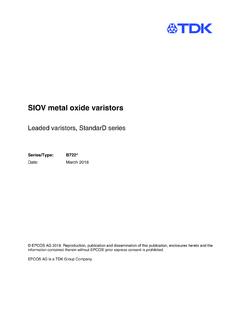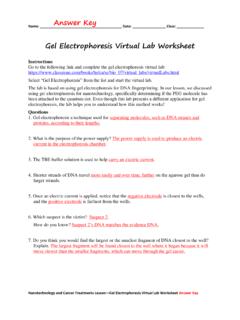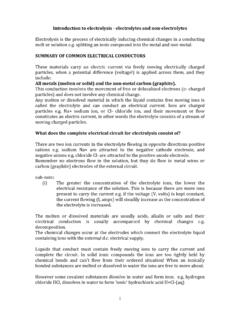Transcription of Aluminum Electrolytic Capacitors - TDK Electronics AG
1 Aluminum Electrolytic CapacitorsGeneral technical informationDate:$ECEMBER 201 TDK Electronics AG 2019. Reproduction, publication and dissemination of this publication, enclosures heretoand the information contained therein without TDK Electronics ' prior express consent is construction of Aluminum Electrolytic capacitorsAIuminum Electrolytic Capacitors assume a special position among the various types of capacitorssince their principle of operation relies, in part, on electrochemical advantages of Aluminum Electrolytic Capacitors that have led to their wide application rangeare their high volumetric efficiency ( capacitance per unit volume)
2 , which enables the produc-tion of Capacitors with up to one Farad capacitance, and the fact that an Aluminum Electrolytic ca-pacitor provides a high ripple current capability together with a high reliability and an excellentprice/performance is the case with all Capacitors , an Aluminum Electrolytic capacitor comprises two electricallyconductive material layers that are separated by a dielectric layer. One electrode (the anode) isformed by an Aluminum foil with an enlarged surface area. The oxide layer (Al2O3) that is built upon this is used as the dielectric.
3 In contrast to other Capacitors , the counter electrode (thecathode) of Aluminum Electrolytic Capacitors is a conductive liquid, the operating electrolyte. Asecond Aluminum foil, the so-called cathode foil, serves as a large-surfaced contact area for pass-ing current to the operating 1 Basic construction of an Aluminum electrolyticcapacitorC CapacitanceF 0 Absolute permittivityAs/Vm rRelative permittivity( for Al2O3)A Capacitor electrode surface area m2d electrode spacingmThe anode of an Aluminum Electrolytic capacitor is an Aluminum foil of extreme purity.
4 The effec-tive surface area of this foil is greatly enlarged (by a factor of up to 200) by electrochemical etch-ing in order to achieve the maximum possible capacitance values. The type of etch pattern andthe degree of etching is matched to the respective requirements by applying specific technical informationPage 2 of 39 Please readImportant notesandCautions and foils enable very compact Aluminum Electrolytic capacitor dimensions to be achieved andare used almost exclusively nowadays. The electrical characteristics of Aluminum Electrolytic ca-pacitors with plain (not etched) foils are, in part, better, but these Capacitors are considerably larg-er and are only used for special applications 2 Structure of anode foil for high-voltagecapacitors (magnification 300x)Figure 3 Structure of anode foil for low-voltagecapacitors (magnification 400x)The dielectric layer of an Aluminum Electrolytic capacitor is created by anodic oxidation (forming)
5 To build up an Aluminum oxide layer on the foil. The layer thickness increases in proportion to theforming voltage at a rate of approximately nm/V. Even for Capacitors for very high voltages,layer thicknesses of less than 1 m are attained, thus enabling very small electrode is another reason for the high volumetric efficiency achieved ( in comparison to the mini-mum thickness of a paper dielectric, 6 to 8 m).During the forming process the very fine pits of the etched foils will encrust partially in proportionto the forming voltage.
6 Due to this effect, the final operating voltage range must already be takeninto account when the foils are oxide layer constitutes a non-linear voltage-dependent resistance that causes the DC currentto increase more steeply as the voltage increases. A characteristic curve as shown in figure 4 Rated voltageVS= Surge voltageVF= Forming voltageI = DC currentFigure 4 Current-voltage characteristic of analuminum Electrolytic capacitorGeneral technical informationPage 3 of 39 Please readImportant notesandCautions and the forming voltage VFis exceeded, the forming process restarts and large amounts of gasand heat are generated.
7 The same effect, yet on a smaller scale, can already be observed in theknee of the curve. In order to achieve a high degree of operating safety of the capacitor, the ratedvoltage VRis defined as being on the quasi-linear part of the curve. As the capacitor is subjectedto surge voltages VSfor short periods only, this range lies between the rated voltage and the form-ing voltage. The difference between forming voltage and operating voltage, the so-called over-anodization, thus has a substantial effect on the operating reliability of the capacitor.
8 High over-anodization offers the possibility of producing especially reliable Capacitors designated as long-lifegrade "LL" Capacitors to IEC 60384 the Electrolytic Capacitors have a liquid as a cathode, they are also designated as "wet" or"non-solid" Capacitors . The liquid has the advantage that it fills the fine etching pits, therefore opti-mally fitting into the anode two Aluminum foils are separated by paper spacers. The paper serves various purposes, itserves as a container for the electrolyte the electrolyte is stored in the pores of the absorbentpaper and also as a spacer to prevent electric short-circuits.
9 As well as ensuring the required di-electric strength between the anode and cathode 5 Winding construction of an Aluminum Electrolytic capacitorGeneral technical informationPage 4 of 39 Please readImportant notesandCautions and Aluminum Electrolytic capacitor constructed in the way described above will only operate cor-rectly if the positive potential is connected to the formed Al foil (anode), and the negative potentialto the cathode foil. If the opposite polarity were to be applied, this would cause an electrolyticprocess resulting in the formation of a dielectric layer on the cathode foil.
10 In this case strong inter-nal heat generation and gas emission may occur and destroy the capacitor. Secondly, the cath-ode capacitance, which will progressively decrease as the oxide layer thickness increases, andwhich is connected in series with the anode capacitance, would reduce the overall most applications, Aluminum Electrolytic Capacitors as poled devices are used with a DCvoltage bias of proper polarity with some superimposed AC voltage. Reverse polarities of up V are permissible for short periods of time as the formation of a damaging oxide layer on thecathode only starts at voltages of this magnitude.
